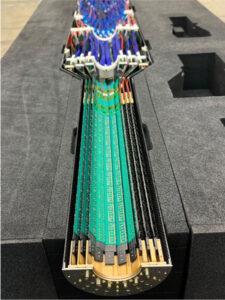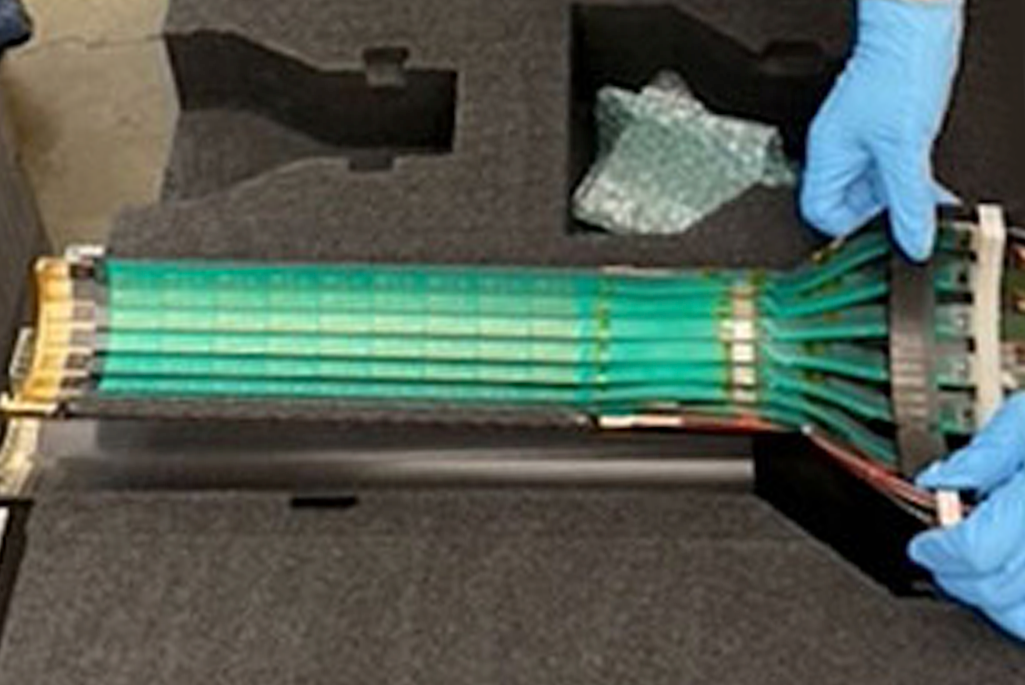Scientists from the Relativistic Nuclear Collisions (RNC) program in Berkeley Lab’s Nuclear Science Division recently completed the assembly of the MVTX vertex detector, which will be installed in the center of sPHENIX experiment at Brookhaven National Laboratory (BNL).
The sPHENIX detector, presently in the final stages of construction, is designed to complete the Relativistic Heavy Ion Collider’s (RHIC) scientific mission to study the microscopic nature of the quark-gluon plasma (QGP), a soup of freely moving quarks and gluons (components of protons and neutrons), created in nuclear collisions at very high energies.
 In particular, the MVTX will aid in the reconstruction and identification of B-mesons (heavy mesons with bottom quarks), which is very important and, at the same time, extremely challenging. It requires high precision tracking close to the interaction point with high detector efficiency (single track efficiency > 80%). The MVTX vertex detector (pictured at right, photo credit: RNC Archive) is based on Monolithic Active Pixel Sensors (MAPS) that were developed for the ALICE experiment at CERN. It was designed to enable such key measurements, and it will also significantly improve other heavy flavor measurements including heavy-flavor correlations measurements at RHIC.
In particular, the MVTX will aid in the reconstruction and identification of B-mesons (heavy mesons with bottom quarks), which is very important and, at the same time, extremely challenging. It requires high precision tracking close to the interaction point with high detector efficiency (single track efficiency > 80%). The MVTX vertex detector (pictured at right, photo credit: RNC Archive) is based on Monolithic Active Pixel Sensors (MAPS) that were developed for the ALICE experiment at CERN. It was designed to enable such key measurements, and it will also significantly improve other heavy flavor measurements including heavy-flavor correlations measurements at RHIC.
The MVTX will be positioned inside the next tracking system component, the Time Projection Chamber (TPC) and it will serve as the innermost tracker for sPHENIX. Its first detection layer will be at 2 mm from the beamline. The MVTX is approximately one foot long and 3.5 inches in diameter and it is accompanied by a seven-foot barrel that houses power and data cables and cooling tubes. It consists of three concentric layers (50 μm thick) supported by carbon composite structures. Each layer consists of advanced detector readout units, each with 9 silicon sensor chips, called staves. The total number of staves built for the MVTX is 84. The total silicon coverage is 0.19 m2.
LBNL had a very significant responsibility in this project: the transportation of 84 staves, produced at CERN, to LBNL (worth US $1.2 M), assembling them onto three concentric layers that will encase the beampipe, precise alignment of the whole detector (to ~20μm level), and shipment of two completed halves of the MVTX detector to BNL. LBNL was also responsible for the power system of the entire detector.
 The team of RNC staff scientists and postdocs, led by Yuan Mei, completed all tasks with flying colors. The MVTX was successfully assembled on time, on budget and within specs, a remarkable feat in particular in view of the challenges during the COVID-19 pandemic. The work was completed in late August 2022, and the detector was delivered to BNL in September. It arrived safely, with all components intact.
The team of RNC staff scientists and postdocs, led by Yuan Mei, completed all tasks with flying colors. The MVTX was successfully assembled on time, on budget and within specs, a remarkable feat in particular in view of the challenges during the COVID-19 pandemic. The work was completed in late August 2022, and the detector was delivered to BNL in September. It arrived safely, with all components intact.
“The secret to that success,” says Yuan Mei, who was in the ‘pilot seat’ throughout the entire assembly process, is that “everybody is onsite with undivided attention.“ (Pictured at right are RNC scientist Yuan Mei and LBNL postdoc Ho-San Ko at the MVTX assembly site at LBNL. Photo credit: RNC Archive.)
The team at BNL is now preparing for insertion tests to ensure that the MVTX can be safely installed in the very center of sPHENIX. We will see it in action very soon, as the sPHENIX experiment will start data taking in a few months.
Learn More
sPHENIX Assembly Update: Magnet Mapped, Detectors Prepared: Collaborators’ sights are set on a spring 2023 start-up for advanced particle detector
December 23, 2022 | Kelly Zegers | BNL Newsroom
Celebrating the Upcoming sPHENIX Detector: Ribbon-cutting held at Brookhaven Lab in anticipation of particle detector’s first collision captures this spring
January 27, 2023 | Kelly Zegers and Karen McNulty Walsh | BNL Newsroom
